11 Weeds With Attractive Yellow Flowers: Hidden gems and repeat offenders.

This post follows our research editorial guidelines.

Have you ever found hidden treasures in your garden? Last summer, my daughter and I had a good reason to let wild strawberry plants with yellow flowers creep across our neatly planted plot. It’s kind of like when you welcome a surprise guest with a smile, even if they come unexpectedly.

If you’re not familiar with wild strawberries, you might easily mistake them for common weeds. While they may not be as sweet as regular strawberries, they provided us with a valuable lesson in patience and exploration.
Many weeds with yellow flowers in this list fall into the same category. If given enough time and attention can leave you delightfully surprised. Let’s re-define what a weed is because most flowers we see are not always a nuisance.
Quickly Find Yellow Weeds:
1. Yellow Sorrel (Oxalis stricta)

Yellow sorrel, also known as yellow wood sorrel or oxalis stricta, is a flowering weed plant that boasts attractive yellow blooms. Despite its invasive nature, many gardeners choose to keep it in their gardens because of its bright and cheerful appearance. I’ve often mistaken these as clovers growing in my garden.
Along with being a pest repellant, Yellow sorrel can even be used as a pH indicator. The color of its leaves can change in response to the pH level of the soil it grows in.
| Botanical Name: | Oxalis stricta |
| Spread Rate: | 12 inches |
| Native Range: | North America |
| Hardiness Zones: | Zone: 4-9 |
| Exposure: | Full sun to partial shade |
| Blooming Season: | June-October |
| Notable Qualities: | Used to repel pests and monitor soil pH |
2. Yellow Toadflax (Linaria Vulgaris)
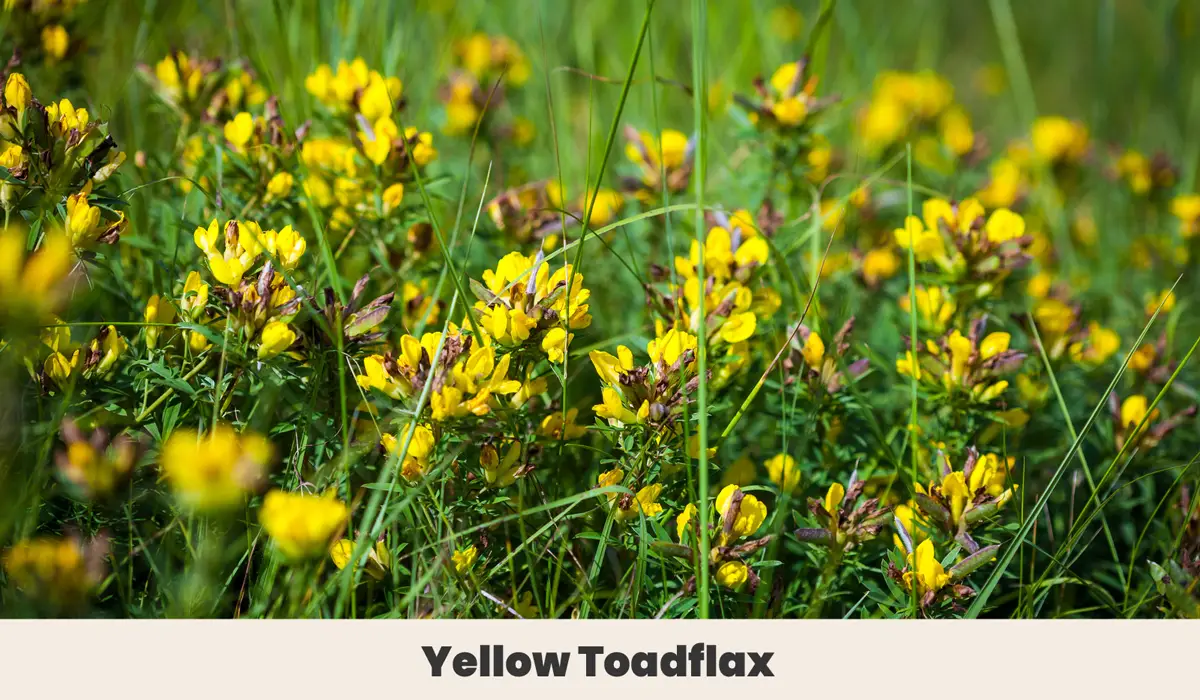
Yellow Toadflax is a weed plant that boasts stunning yellow and orange flowers. While it is considered an invasive species in many parts of the United States, its beautiful blooms have made it a popular choice for gardeners looking to add a pop of color to their landscaping.
However, it is important to note that Yellow Toadflax can spread quickly and compete with native plant species, so it should be carefully monitored and managed to prevent it from taking over. If you see this weed pop up on your lawn, get rid of it quickly!
Personally, I hate using chemical weed control, it’s nasty stuff that I don’t want anywhere near my kids and pets. For this reason, I stick with the manual method of removing Toadflax. Dig down at the base of the weed and look for the lateral root, this is the point where the weed is behind to spread. Cut out the weed and throw it in the city compost bin or your own hot pile of compost that will damage any potential seeds.
| Botanical Name: | Linaria vulgaris |
| Spread Rate: | 1-3 feet per year depending on growing conditions |
| Native Range: | Europe and Asia |
| Hardiness Zones: | Zone: 3-9 |
| Exposure: | Full sun to partial shade |
| Soil Needs: | Well-drained soil |
| Blooming Season: | June-August |
| Notable Qualities: | Often used as a yellow dye in textiles |
3. Yellow Nutsedge (Cyperus esculentus)

Yellow Nutsedge, also known as yellow nutgrass, is a weed plant with bright yellow flowers that can add a splash of color to your lawn or garden. However, this plant is notoriously difficult to get rid of due to its extensive root system and ability to regenerate from even small fragments left in the soil.
If you’re looking for a new plant to forage, Nutsedge has an incredible taste that’s reminiscent of a raw almond. Try mixing with some hot coco and cinnamon for a tasty forest forage treat.
| Botanical Name: | Cyperus esculentus |
| Growth Rate: | Rapid Growth: Up to 6 inches per week |
| Native Range: | North America, Europe, Asia, and Africa |
| Hardiness Zones: | Zone: 7-11 |
| Exposure: | Full sun to partial shade |
| Soil Needs: | Prefers moist soil |
| Blooming Season: | June-October |
| Notable Qualities: | Difficult to control, spreads quickly through underground tubers. Able to outcompete other plants in waterlogged soil. |
4. Yellow Rocket (Barbarea vulgaris)
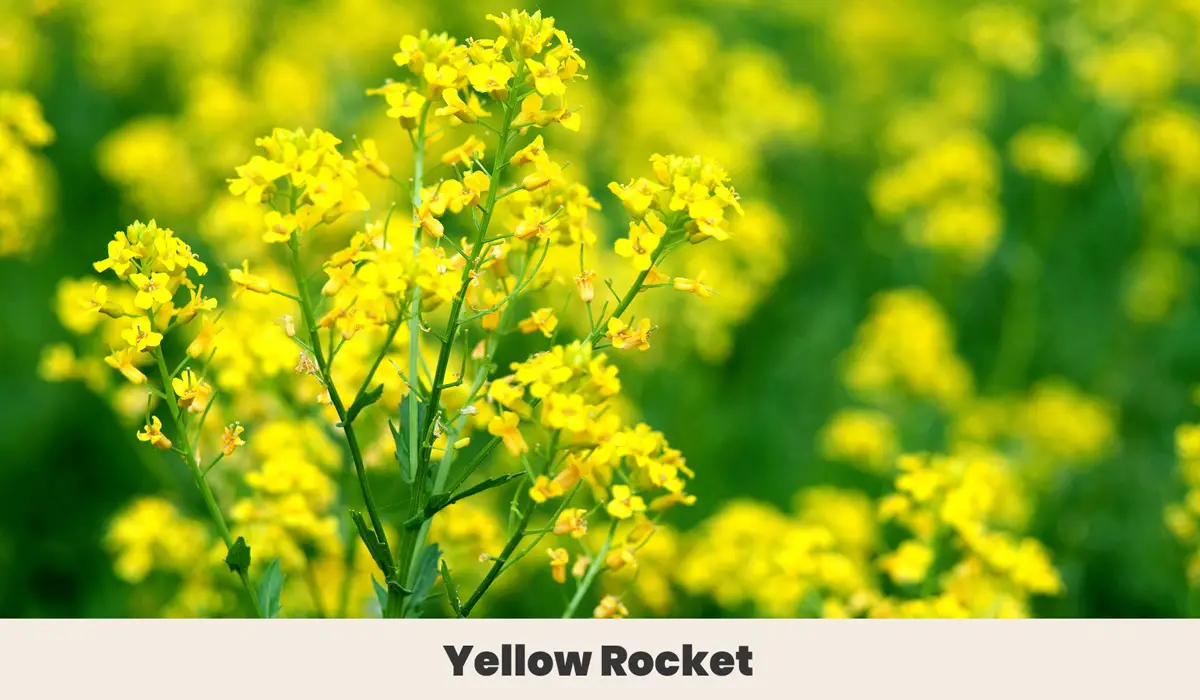
Yellow Rocket, also known as Barbarea vulgaris, is a weed plant that produces striking yellow flowers in the spring and early summer. While it may add a pop of color to your garden, Yellow Rocket is known for being invasive and can quickly take over if not controlled.
However, it does have some practical uses, you might have heard the word “rocket” before when picking greens to grow in your garden. That’s because Yellow Rocket is part of that same family line of brassicas. The leaves can be sauteed or eaten raw for their mustard-like flavor.
| Botanical Name: | Barbarea vulgaris |
| Growth Rate: | 12-17 inches per year |
| Native Range: | Europe, Asia, and North America |
| Hardiness Zones: | 5-9 |
| Exposure: | Full sun to partial shade |
| Soil Needs: | Requires moist, nutrient-rich soil |
| Bloom season: | April-June |
| Notable Qualities: | Edible flowers |
5. Yellow Salsify (Tragopogon dubius)
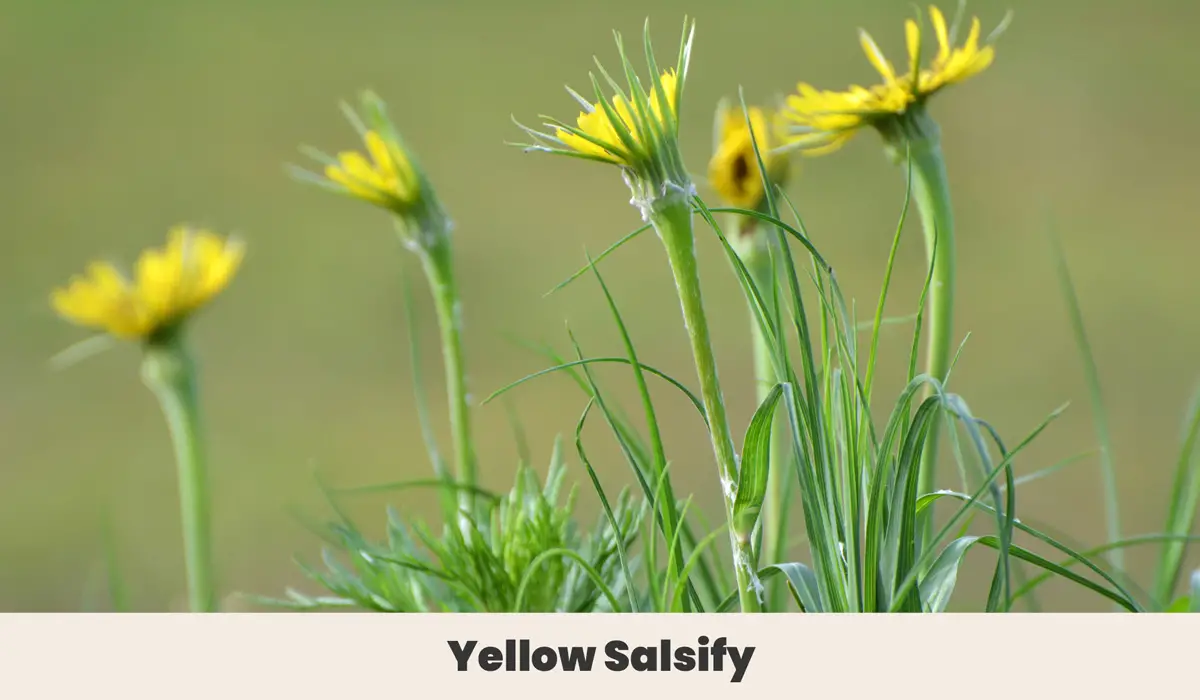
Yellow Salsify, also known as Tragopogon dubius, is a weed plant that produces beautiful yellow flowers that resemble dandelions or little yellow daisies.
It is also edible and has a sweet, nutty flavor that can be used in salads or cooked as a vegetable. If you’re not in a foraging mood, leave the seeds plants intact as they go to seed to provide a treat for nearby birds to feed.
| Botanical Name: | Tragopogon dubius |
| Growth Rate: | 12-24 inches per year until going to seed |
| Native Range: | Europe and Asia |
| Hardiness Zones: | Zone: 3-9 |
| Exposure: | Full sun to partial shade |
| Soil Needs: | Requires well-drained and sandy loam soil |
| Bloom season: | May-June |
| Notable Qualities: | Expect first-year plants to be vegetative, flowers will be produced in year 2. |
6. Creeping Buttercup (Ranunculus repens)

Creeping Buttercup, also known as Ranunculus repens, is a weed plant with bright yellow flowers that can add a pop of color to your garden or lawn. While it may be visually appealing, Creeping Buttercup can be difficult to control and can spread rapidly.
In fact, buttercups are listed on the invasive species list in North America and New Zealand. As bright and cheerful as these flowers seem, it’s best to not let them run loose in your garden.
| Botanical Name: | Ranunculus repens |
| Growth Rate: | 1 foot |
| Native Range: | Europe, Western Asia, North Africa |
| Hardiness Zones: | Zone: 4-9 |
| Exposure: | Full sun to partial shade |
| Soil Needs: | Moist soils with good drainage |
| Bloom season: | May to August |
| Notable Qualities: | Useful as a ground cover plant |
7. Garden Loosestrife (Lysimachia vulgaris)
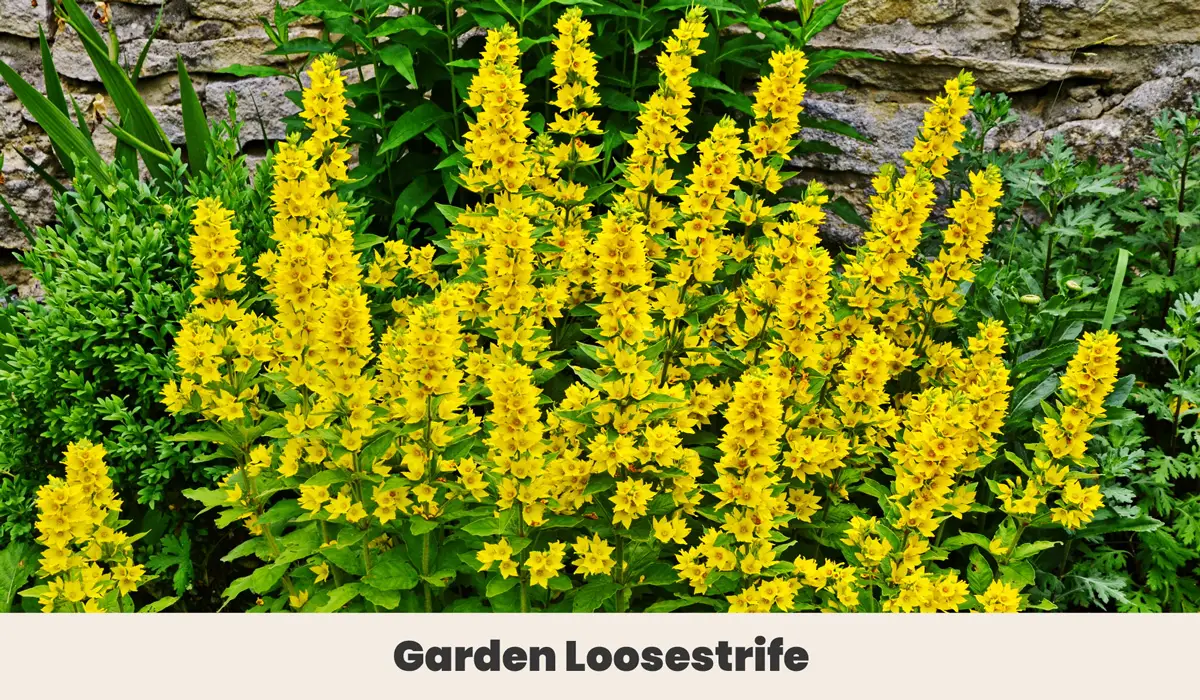
Garden Loosestrife, also known as Lysimachia vulgaris, is a weed plant with beautiful yellow flowers that can add a burst of color to your garden. However, it can be invasive and difficult to control, spreading quickly through underground rhizomes.
It is essential to manage Garden Loosestrife carefully to prevent it from taking over and outcompeting other plants.
| Botanical Name: | Lysimachia vulgaris |
| Growth Rate: | 10-24 inches per year |
| Native Range: | Europe and Asia |
| Hardiness Zones: | Zone: 4-8 |
| Exposure: | Full sun to partial shade |
| Soil Needs: | Requires well-drained and moist soil |
| Blooming time: | April to September |
| Notable Qualities: | Thrives in consistently damp to wet soil, and grows well near ponds. |
8. Grass-leaved Goldenrod (Euthamia graminifolia)
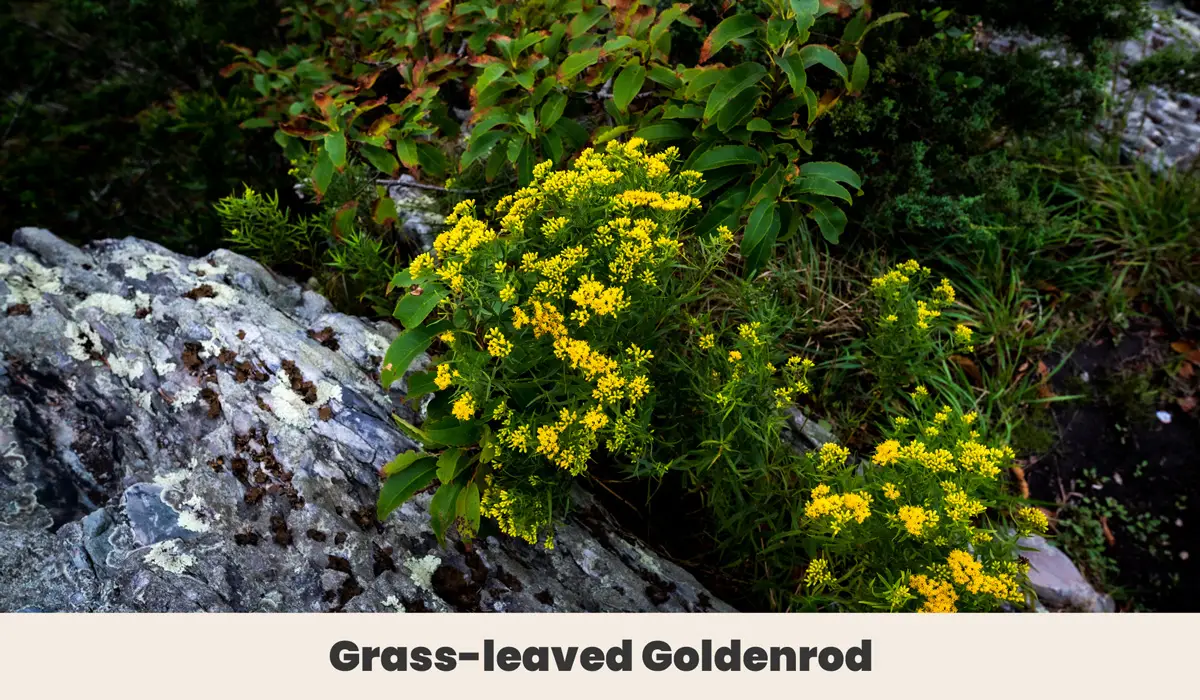
Grass-leaved Goldenrod, also known as Euthamia graminifolia, is a native North American weed plant that produces clusters of bright yellow flowers in the late summer and early fall.
While it may be considered a weed by some, it is an important source of nectar for pollinators like bees and butterflies.
| Botanical Name: | Euthamia graminifolia |
| Growth Rate: | 3-4 feet |
| Native Range: | North America |
| Hardiness Zones: | 3-9 |
| Exposure: | Full sun to partial shade |
| Soil Needs: | Prefers well-drained soil |
| Blooming Period | June-September |
| Notable Qualities: | Used to restore natural habitats and prevent soil erosion |
9. Common Evening Primrose (Oenothera biennis)

Common Evening Primrose, or Oenothera biennis, is a bright and beautiful yellow perennial that produces showy yellow flowers that bloom at night. Despite being considered a weed, primrose produces loveley little seeds that can be roasted or eaten raw.
However, its spreading nature and ability to take over garden beds make it a difficult plant to control, and many gardeners opt to remove it from their gardens.
| Botanical Name: | Oenothera biennis |
| Growth Rate: | 6 feet |
| Native Range: | North America |
| Hardiness Zones: | Zone: 3-9 |
| Exposure: | Full sun to partial shade |
| Soil Needs: | Prefers well-drained soil |
| Blooming Period: | June-September |
| Notable Qualities: | Biennial Plant that blooms during the second year of growth, produces small edible seeds. |
10. Bird’s Foot Trefoil (Lotus corniculatus)
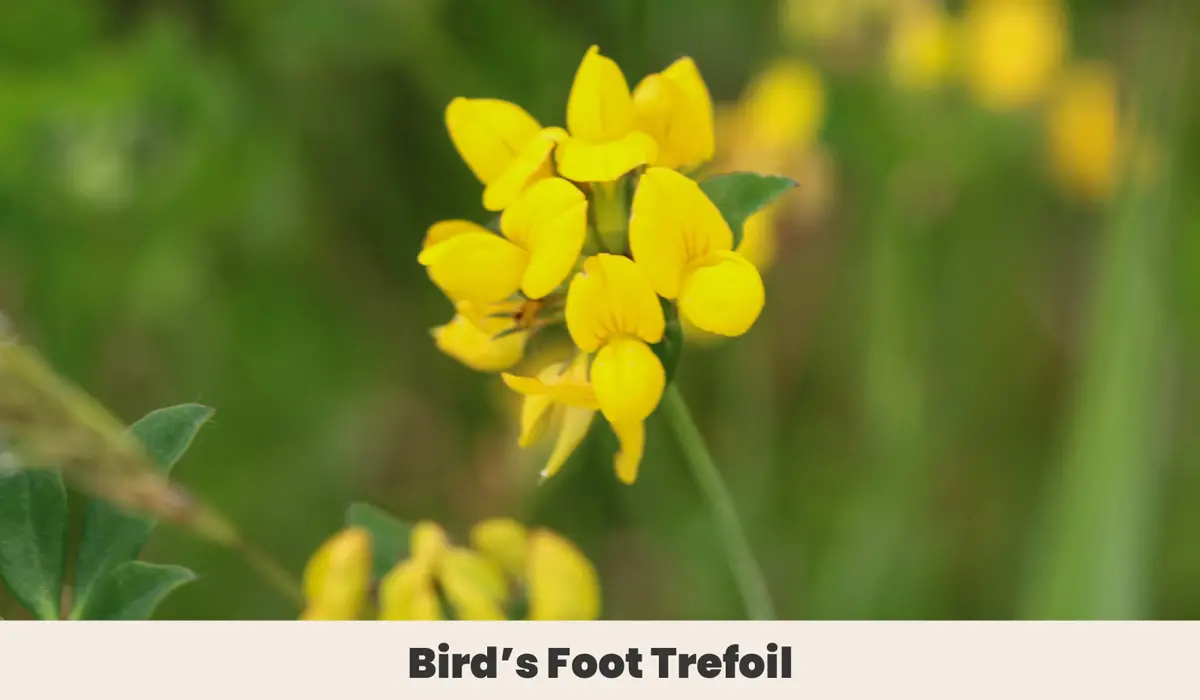
Bird’s Foot Trefoil is a hardy weed plant that features vibrant yellow flowers that attract bees and butterflies. It is a low-maintenance plant that thrives in poor soil and is often used in erosion control.
Its delicate, fern-like foliage adds an interesting texture to gardens, making it a popular choice among gardeners who appreciate its unique appearance.
| Botanical Name: | Lotus corniculatus |
| Growth Rate: | 2 Feet |
| Native Range: | Europe and Asia |
| Hardiness Zones: | 3-9 |
| Exposure: | Full sun to partial shade |
| Soil Needs: | Prefers well-drained soil |
| Blooming Period: | June-July |
| Notable Qualities: | Used to control and prevent soil erosion |
11. Black Medic (Medicago lupulina)
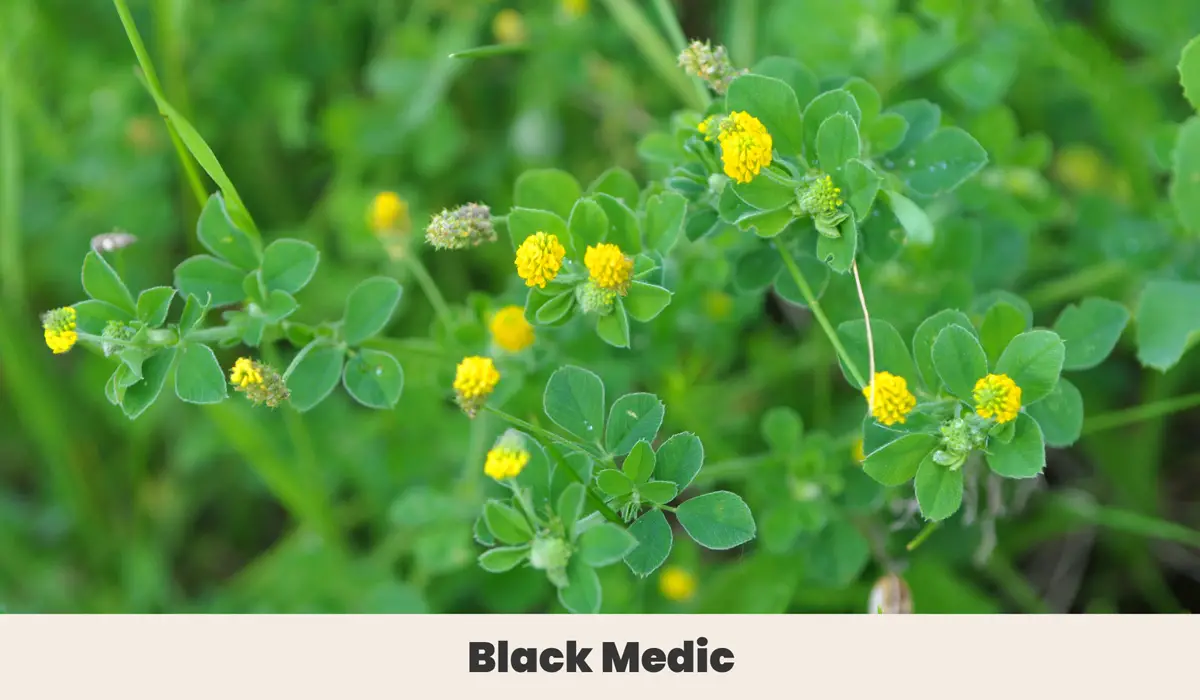
The flowering plant known as black medic (Medicago lupulina) is a member of the Fabaceae family of legumes. It is also referred to as “hop medic” or “black clover.” This biennial plant grows up to 60cm tall and has small yellow flowers that bloom from May to October.
In lawns, gardens, and agricultural fields, black medic is frequently seen as a weed, but it can also be grown for livestock fodder. It can grow in a variety of soil types, including poor, compacted, or drought-prone soils, and has a shallow root system. Another property of black medic is its ability to fix nitrogen in the soil, which helps surrounding plants.
| Botanical Name: | Medicago lupulina |
| Growth Rate: | 2 Feet |
| Native Range: | Europe, Asia, and North Africa |
| Hardiness Zones: | 2-10 |
| Exposure: | Full sun to partial shade |
| Soil Needs: | Prefers well-drained soil |
| Blooming Period: | May to October |
| Notable Qualities: | Improves soil quality through nitrogen-fixing fungus |
Final Thoughts
While these 11 weeds with attractive yellow flowers may have a reputation as unwanted invaders, they can also bring a bright pop of color and even some benefits to your garden or landscape.
Whether you choose to embrace them or remove them, it’s always worth taking a closer look at the beauty that surrounds us in nature. So, next time you’re out and about, keep an eye out for these sunny yellow blooms and appreciate the beauty that they bring to the world around us.
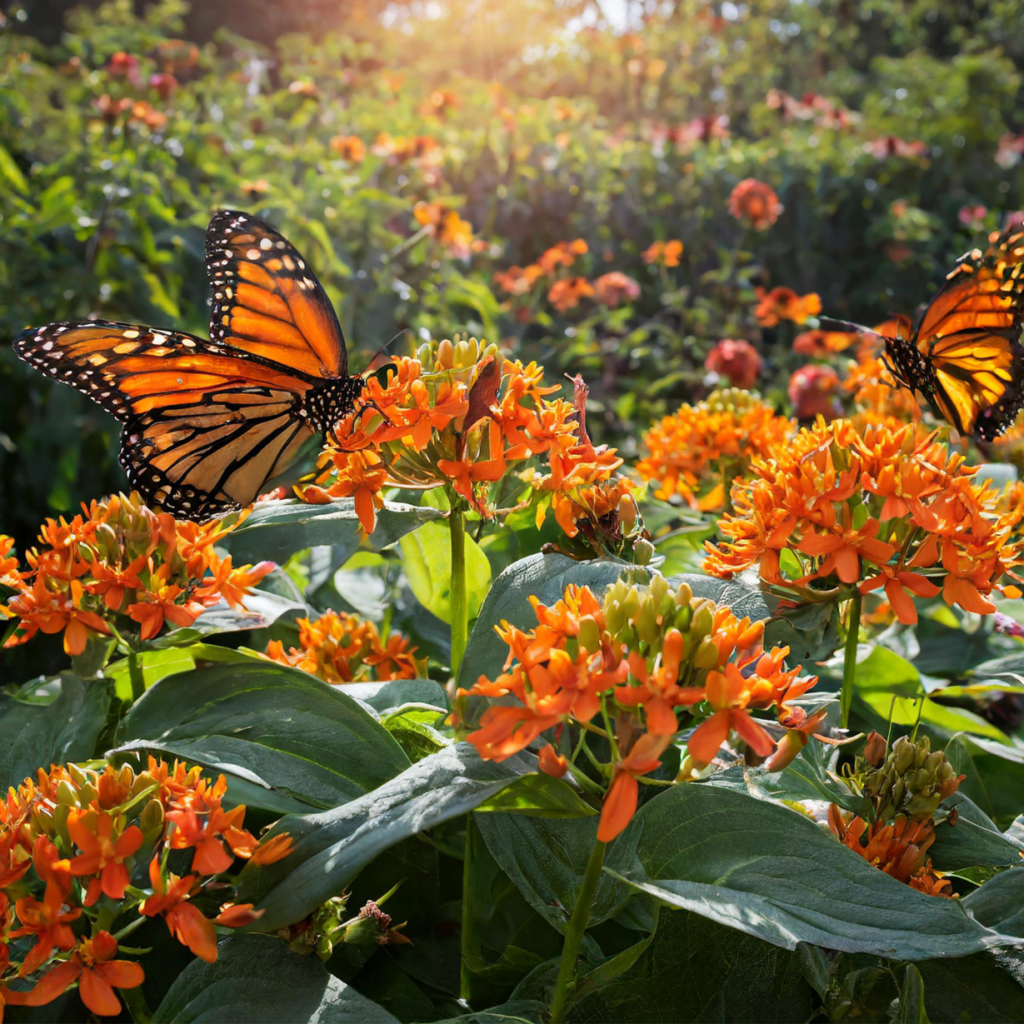

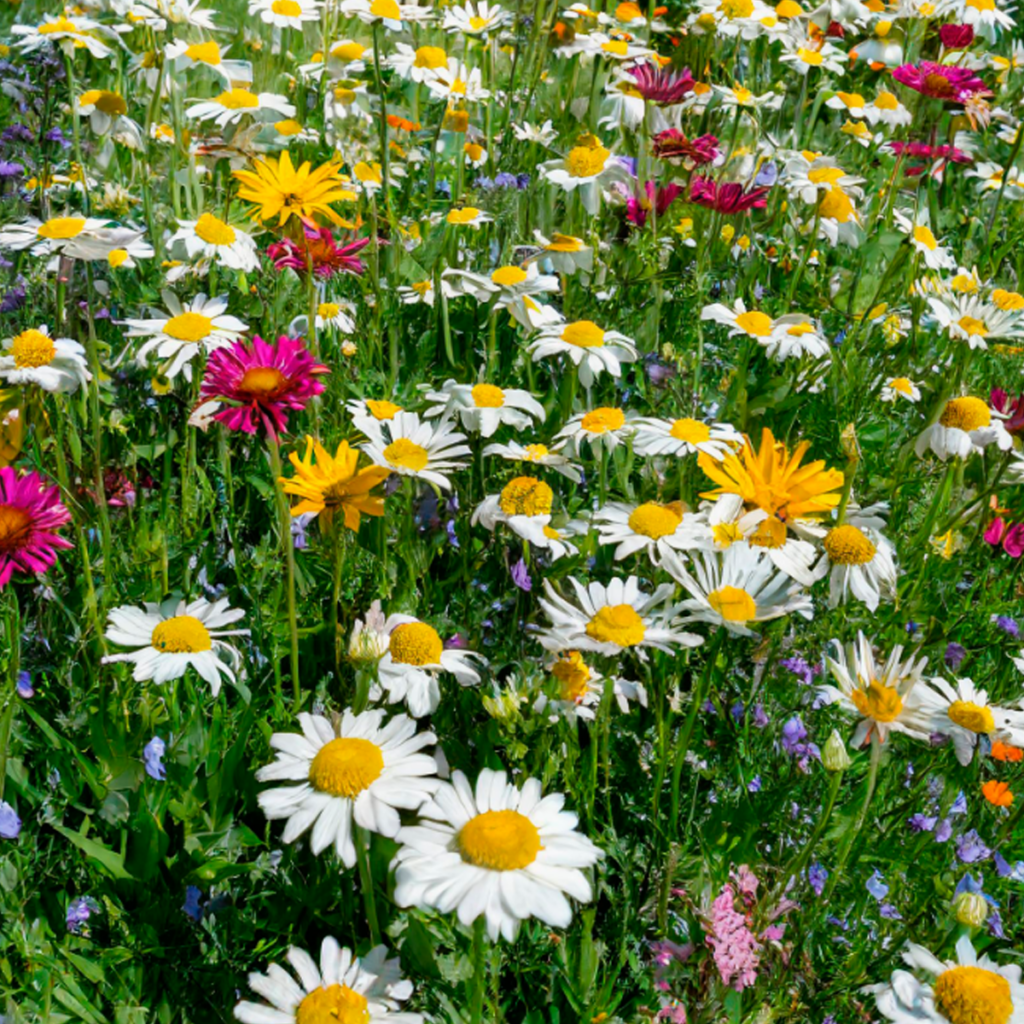


you have got a terrific weblog here! would you wish to make some invite posts on my blog?
Thank you for the interest! Not at this time though 🙂
I discovered your blog site website on the search engines and appearance some of your early posts. Always maintain up the good operate. I extra increase your RSS feed to my MSN News Reader. Looking for toward reading more from you finding out afterwards!…
Thanks Nancy! Great to see you found my tips on identifying yellow weeds helpful. 🙂